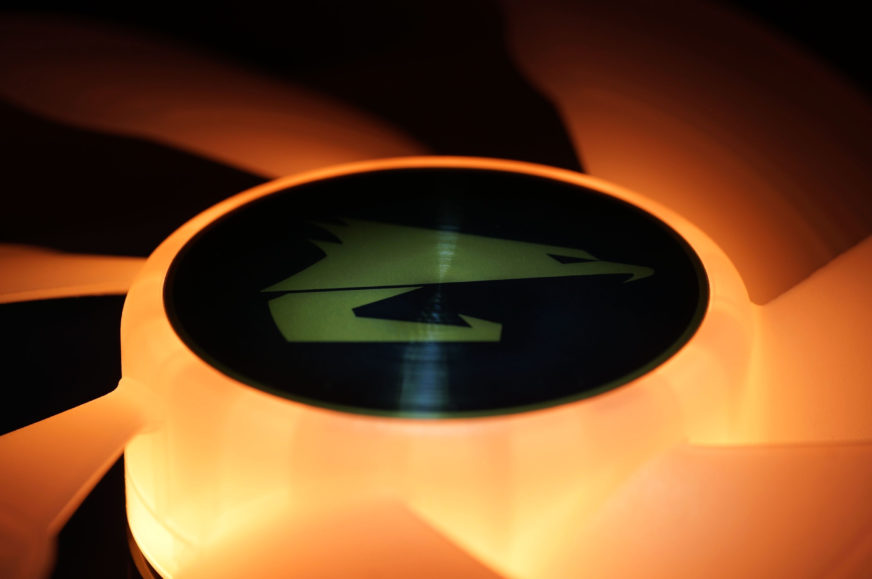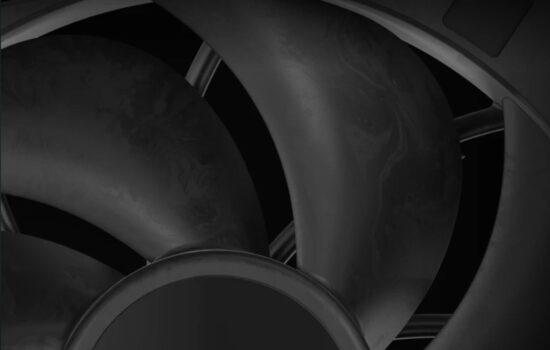Gigabyte Aorus 140 ARGB in detail
Blade length is always the “topic”, but will be more common with 140mm fans than smaller variants. Some bet on long blades for preference of selected features, the other manufacturer on short ones. And such (short) and overall more robust blades are also used by the 140mm Aorus fan. From certain points of view this is quite a big advantage, but for which something had to be sacrificed. It’s a quid pro quo.
Evaluation
The Aorus 140 ARGB doesn’t quite reach the top spots in airflow and static pressure, but it doesn’t suffer from the typical critical shortcomings of more “powerful” competing fans. Taking it in order from the most essential, compared to the 140mm fan BeQuiet! Light Wings the acoustic response of the Aorus 140 is considerably more pleasant. The sound frequencies are more balanced, with no pronounced peaks (although there are some sharper peaks), and the operation sound is characterised mainly by the aerodynamic component that no fan can avoid. Across different formats (120/140 mm) of Aorus ARGB and BeQuiet! Light Wings, the different approach of these companies is noteworthy. While BeQuiet! used short blades in the smaller (120mm) variant, Gigabyte has them in the larger variant, which makes sense for suppressing lower, rumbling sound frequencies.
Compared to the 120 mm variant (Aorus 120 ARGB), this 140 mm (Aorus 140 ARGB) is more aerodynamically efficient in all situations due to its larger cross-section. Only a little bit, but it is. What the Aorus fans have in common is that they both collide with an unreinforced dust filter. The height difference between the rotor and the frame is too small and the filter screen thus comes into unwanted contact.
With the sturdier plastic filters everything is already fine and even the results of the Aorus 140 ARGB are remarkable. This is a use case where even the average 140mm fan beats a top-of-the-line 120mm one. The Aorus 140 ARGB also has the edge here over the Noctua NF-A12x25 PWM. The gap to the FD Aspect 14 RGB PWM is minimal at higher to very low speeds and the other benefits of the Gigabyte fan, which we’ll get to below, may weigh in for choosing the Aorus 140 ARGB.
For those who want to run the fan at the limit of audibility, at very low speeds, the Aorus 140 ARGB is not suitable (and another fan would be more suitable). With this setup, the Aorus 140 ARGB’s ranking starts to slip regardless of the type of obstacle it’s operating on. In fact, the static pressure is already too low even without it.
On a grille and on radiators, the Aorus 140 ARGB stays in the band of above-average efficient (in terms of airflow/noise ratio) 120 mm fans, and there are certainly more attractive models for this use. But how many of them will sound similarly acceptable/unintrusive across the entire speed range is already a question. And there probably won’t be many models with zero vibration on the bezel, like the Aorus 140 ARGB, either.
The Aorus 140 ARGB fan also excels in extremely low operating power draw (up to 1 W for the motor), which confirms Gigabyte’s words about lower friction of mechanical elements – less force is enough for the same rotation speed. That’s also why the Aorus 140 ARGB achieves twice the airflow per watt compared to the FD Aspect 14 RGB PWM, and it also tops the BeQuiet! Light Wings (BL075), although there the difference is already smaller. Lighting efficiency is also high thanks to the large light guide. Its luminosity is above average. If you are interested in a 140 mm fan with an ARGB LED that shines brightly and does not rumble, the Gigabyte Aorus 140 ARGB is among the first in line.
English translation and edit by Jozef Dudáš
| Gigabyte Aorus 140 ARGB |
| + Suitable for any scenario |
| + Cooling efficiency (airflow/pressure per unit of noise) at a high level |
| + Sound is always (regardless of application) more pleasant than the vast majority of other fans |
| + Very low power draw (under 1 W) |
| + Sometimes as a system fan at low speed it beats even the most efficient 120 mm models |
| + Very high efficiency even with dust filters |
| + Wide speed range |
| + Very low speeds possible (stable from approx. 205 rpm) |
| + Zero vibration across the entire speed spectrum |
| + Rotor lighting |
| - Relatively lower airflow per dBA... |
| - ... around the level of average 120 mm fans. Especially at low speeds (below 600 rpm) |
| - Weaker price/cooling performance ratio for a 140mm fan |
| - Only plain bearings, but with reduced friction, so hopefully they will last longer |
| - Collides with nylon dust filter |
| Approximate retail price: 28 EUR |
- Contents
- Gigabyte Aorus 140 ARGB in detail
- Basis of the methodology, the wind tunnel
- Mounting and vibration measurement
- Initial warm-up and speed recording
- Base 6 equal noise levels…
- ... and sound color (frequency characteristic)
- Static pressure measurement…
- … and airflow
- Everything changes with obstacles
- How we measure power draw and motor power
- Measuring the intensity (and power draw) of lighting
- Results: Speed
- Results: Airlow w/o obstacles
- Results: Airflow through a nylon filter
- Results: Airflow through a plastic filter
- Results: Airflow through a hexagonal grille
- Results: Airflow through a thinner radiator
- Results: Airflow through a thicker radiator
- Results: Static pressure w/o obstacles
- Results: Static pressure through a nylon filter
- Results: Static pressure through a plastic filter
- Results: Static pressure through a hexagonal grille
- Results: Static pressure through a thinner radiator
- Results: Static pressure through a thicker radiator
- Results: Static pressure, efficiency by orientation
- Reality vs. specifications
- Results: Frequency response of sound w/o obstacles
- Results: Frequency response of sound with a dust filter
- Results: Frequency response of sound with a hexagonal grille
- Results: Frequency response of sound with a radiator
- Results: Vibration, in total (3D vector length)
- Results: Vibration, X-axis
- Results: Vibration, Y-axis
- Results: Vibration, Z-axis
- Results: Power draw (and motor power)
- Results: Cooling performance per watt, airflow
- Results: Cooling performance per watt, static pressure
- Airflow per euro
- Static pressure per euro
- Results: Lighting – LED luminance and power draw
- Results: LED to motor power draw ratio
- Evaluation













Nice to see the 140mm fan reviews rolling!
Also, would it be possible to publish noise samples for your fan/cooler reviews? Preferably for all scenarios where you perform frequency analysis?
And they will continue to come, tests of 140 mm fans. But we probably won’t exaggerate it, so that they stay in a relevant ratio (according to the interest in whichever format in general) to 120 mm models.
Which noise samples do you mean? From spectrographs? Do you want that data for your own purposes, for your own analysis? If so, we can send you the noise levels at all frequencies in all tested scenarios almost immediately (e.g. by e-mail). We can certainly post them on the web somewhere, but it will take more time, as we will need to create a section for this somewhere. Making it make sense on the web will be more time-consuming and at the moment we are quite overloaded and it is hard to find space for extra activities. :/
Always looking forward to your fan reviews regardless of size!
For noise samples, I mean audio files so I can listen to them to make a subjective judgement. In reviews you often mention the differences in frequencies between obstacles/fan models etc. With audio files to listen to, it will be much more easy to understand the difference.
Maybe you can consider compiling the audio files for each fan and upload to YouTube as a video, for example, which perhaps take relatively little effort, though I am not sure if the audio quality is satisfactory. Anyway, it is only a suggestion so please decide on whether you think it is worth the effort or not.
I understand now, and I am also sorry that I am now likely to disappoint you.
Sound recordings are something I boycott against and the goal is to get more and more people to learn to read spectrograms. Sure, it’s more complicated, but we plan to publish materials to facilitate reading these charts. We will select a few fans that have the biggest differences in the frequency characteristic of the sound, make a sound recording of them, and put a spectrogram against it. On it we then explain which component of the sound represents what in the spectral analysis.
You know, I’m willing to sacrifice all my time for these things, but I have to see some meaning behind the results. And sound recordings don’t make sense to me because they can be extremely misleading. While the user thinks he’s hearing the fan, the sound system with the speaker on top is laughing at how they have been perfectly fooled. It is certainly not necessary to elaborate that the same recording sounds different on each speaker (it is determined by the frequency characteristics of the sound equipment of the end user), and this also with regard to the volume that the person sets. To judge something on the basis of the sound recording is therefore very inaccurate and misleading. I would probably suffer a lot when making them with my high demands on the relevance of things and at the same time it would reduce the relevance of spectrogram, which everyone sees the same way.
I believe that after this message you will not give up on our tests and sooner or later you will surely find out (also with the help of various auxiliary materials, which we plan to publish on this topic), that you understand everything perfectly also with the help of spectrograms. 🙂
Not disappointed at all, very satisfied with your answer. Looking forward to the articles explaining spectrograms, I’ll admit I never really understood how to interpret them.